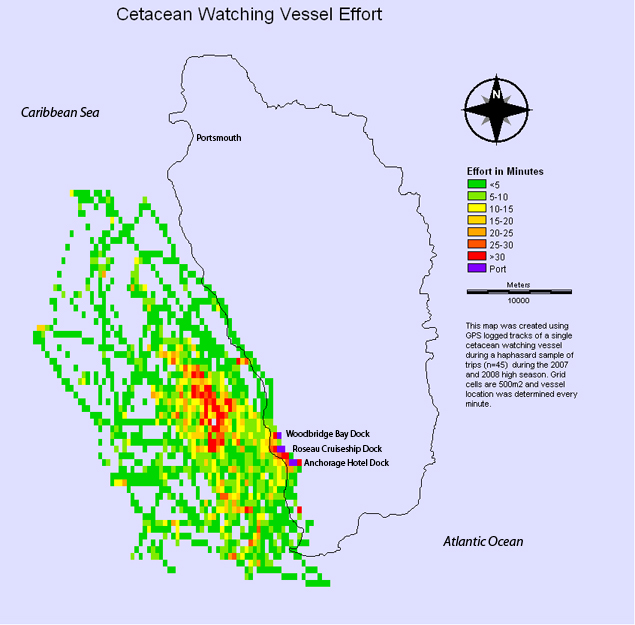Results
Location and Intensity of Cetacean Watching Vessel Effort :
Figure 13, below, displays the 333.5km2 covered by a single vessel from one of the operators in Domincia. Although much of the length of the island is covered on occasion by the CW vessel, effort is biased to the southern half of the leeward coast, likely due to the tours departing from ports at the south end of the island. A significant amount of effort is concentrated into a relatively small area on the central coast. An area of 40.25km2 had vessel traffic which lasted over 15 minutes and 9.5km2 of that area had vessel traffic which lasted greater than 30 minutes. On any given trip, the minimum amount of time in a given grid cells is 1 minute and the maximum (outside of at port area) is 48 mintues. When summed across all trips, an area of 500m2 (one grid cell) has a mean effort of 6.9 minutes (SD=12.81 range: 1-180).

Figure 13 - Effort per 500m2 cell for 45 cetacean watching trips aboard a signle vessel from one operator.
It is important to note that these results were determined throught the analysis of only 45 trips of one vessel from one operator across two years. High tourism season in Dominica runs from December to May. A conservative estimate of the number of trips per week by the main three operators on the island would be 10 (actual data on the number of trips per week is unavailable). As such, these findings are truely only representational for a month of effort during high tourism season. The implications of this are concerning. Should these results be multiplied to simulate 10 trips a week for even a single season (actual simulations in Idrisi were not possible due to the spatially dependent nature of my trackline dataset), the amount of effort on the time on the water becomes increasingly large, as would be the predicted area covered. It is difficult to say how much CW vessel traffic is too much; however, recent work suggest that even the increase of the fleet by one vessel can have dramatic effects on the population numbers, reproductive sucess, and habitat use (Bejder 2005; Bejder et al. 2006a,2006b). In fact, the findings by Bejder and colleagues (Bejder 2005; Bejder et al. 2006a,2006b) were from an area which only had one CW vessel and increased its effort with a second vessel. In Dominica; however, there are currently three operators with dedicated CW vessels, two of which often run two trips at a time.
The majority of CW guidelines around the world support a 30 minute maximum for interactions with animals during a tour (Carlson, 2007). Williams and Ashe (2007) suggest that killer whales are able to detect CW vessels at least 1km away. Taking these two facts, together with the fact that the findings of this analysis are for only one vessel, it is not difficult to concieve a situation in which the cetacean species off the coast of Dominica are likely within 1000m (two grid cells) of a vessel for longer than 30 minutes on most days during the high tourism season when within this 40km2 region of highest CW effort off the central coast. Further analysis which control for temporal changes in effort and distribtuion of cetceans would be needed to confirm this theory.
When this effort map is conpared to the species diversity map, one can see that the area of highest effort is also one of the diversity hotspots. This can be interpreted in two manners: 1) it could be seen as promising, given that there remains a high species diversity in the area that is most impacted by CW; or 2) it could be a concern, given that CW vessels are intensifying their effort in diverse areas. Which interpretation should be taken away from this analysis is difficult to determine without historical data on the abundance and distribution of cetaceans prior to the onset of CW in Dominica. Without such data, it is challenging to conclude whether the patterns identified here are the result of a shifted baseline. What can be drawn from these analysis, is that the distribution and abundance of cetaceans does not appear to be biased to areas that were surveyed by the research boat but have low CW effort.
Continue to Results:Best Cetacean Watching Areas
